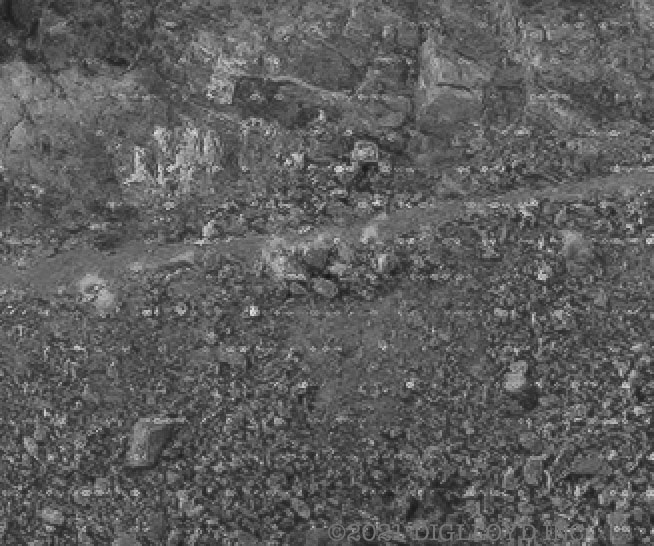Don’t even Think about Using the Fujifilm GFX100S for Monochrome Landscape Images — Horizontal White Stripes Make Images Unusable
re: Reader Comment: Fujifilm GFX100S and Captures for Monochrome
re: PDAF banding and striping pattern noise
re: Fujifilm GFX100: those PDAF Pixels Make Me Wish I Could have a GFX100 Without Them
re: Fujifilm GFX100S: Unacceptable Image Quality for Monochrome Images — Horizontal White Stripes
re: Fujifilm GFX100S Image Quality Defect: PDAF Pimples
At least for making monochrome landscape images, the Fujifilm GFX100S is a total 'FAIL'. No one in their right mind should consider using it for monochrome imagery for landscapes.

Fujifilm GFX100S
Below, the entire image as shown is an unusable disaster because of prominent white stripes everywhere (plain to see at at a bit larger size than shown).
Includes images up to full resolution, plus crops and ACR settings used.
I feel like a sucker, having purchased the Fujifilm GFX100S. Instead of versatility, I have a $6000 camera with apparently an inherent defect that offers strictly limited post processing options. Which is a shame, because without the striping problems the GFX100S would be the best overall camera on the market for monochrome image making, due to its incredible detail capture. The Fujifilm GFX100 shares this problem as per my findings in 2019.
Below, looks nice, eh? Not so much—fine for Instagram but I can do that with an iPhone. The image is unusable for any larger reproduction—marred by horizontal stripes in sky and land, which I show in the crops per the link above.
More below...

Fujifilm GFX100S + Fujifilm GF 80mm f/1.7 R WR @ 65.8mm equiv (80mm) + polarizer Breakthrough Photography X4
ENV: White Mountains, altitude 11800 ft / 3597 m, 55°F / 12°C
RAW: vignetting corrected, +81 Shadows, -100 Highlights, +40 Whites, +20 Contrast, +50 Dehaze, +15 Clarity, diffraction mitigating sharpening
[low-res image for bot]
Prognosis
Can Fujifilm fix these horizontal white stripes with a firmware update? Doubtful.
The striping issue has existed since the release of the GFX100 as per my findings in 2019, yet it has not been fixed. Worse, IMO, Fujfilm has not been forthright about the issue, leaving me to suppose that it is an attempt to ignore the issue and hope it will not gain traction.
I do not have any Fujifilm contacts, nor has anyone from Fujifilm contacted me. I am stunned at how a camera company can ignore blogs like mine, which function essentially as a free outside quality control and R&D resource!
Joseph C writes:
Have you seen the PDAF pimples or horizontal stripes when using EFCS or mechanical shutter? I’m asking because I haven’t been able to duplicate your results with the GFS 100S (and LR/ACR).
DIGLLOYD: on my to do list are the 6 combinations of 14/16 bit X ES/EFC/MS X polarizer/none. The trick is finding a situation like the one above, verifying that the issue occurs (requires the computer), then taking all 12 combinations to see if any of those factors have an influence.
Thing is, EFC and MS are not viable for guaranteed full sharpness due to shutter shake, as Jim Kasson has shown—always a little less sharp than ES (electronic shutter). Might not matter at 30mm or 50mm, but surely matters at 110mm on up. So ES is the only way to go for fully sharp images, guaranteed, at least at some shutter speeds and more so with longer lenses, particularly the Fujifilm GF 250mm f/4.
I reproduced the horizontal lines at home at 500' elevation as the original proof. The recent findings on PDAF pimples and the example above were both at higher elevation (7600' and 11800' respectively), where there is considerably more UV/violet/blue light. In particular the shadow areas in the image above were getting a lot of skylight. However, use of a polarizer makes no difference, and since it cuts down blue light substantially, the blue light hypothesis seems dubious.
Proving and disproving
Speaking in general, absence of proof is not proof of absence. If you are not seeing an issue on your camera, that is at best only proof of absence in the specific shooting environment you used. it is not proof of absence—don’t fall fall for a logical fallacy.
The existence of the problem is proven by my examples, and I could show dozens more. The only thing that remains is to determine what provokes it. Possibilities (items struck-through have been ruled out by testing):
- Camera specific eg "bad camera"? Ideally I’d have two GFX100S camera bodies I could shoot side-by-side. If both showed exactly the same results or conversely if one did and one did not, that would be very useful information.
- Lighting: UV/violet/blue, etc. Blue light seems involved given the sky, but maybe that is just because the sky makes it more obvious and it is such a pure hue.
- Subject matter and its colors, like blue sky. But even the land is affected at times, as per my example and that was true two years ago with the GFX100 also.
Polarizer.14/16 bit capturesbecause the choice directly affects sensor transit time as well as different A/D conversion.Shutter mode: ES/EFCS/MS.Shutter speed.
UPDATES
On June 2, I systematically looked into some of the above potential variables.
- Shutter (ES, EFCS, MS) makes no difference.
- 14-bit and 16-bit lossless make no difference.
- Polarizer makes no difference.
- Tentatively, shutter speed does not appear to make any difference. I tested {1/110, 1/45, 1/25, 1/10, 1/6, 0.3} seconds with no difference seen.
For those who want to try to reproduce:
Find a patch of blue sky with a gradient, because visibility of the striping varies with density. Clear solid blue, no haze, because haze tends to mask the stripes.



























